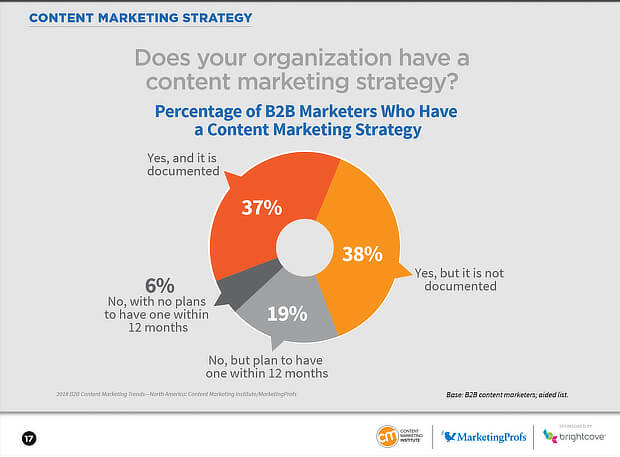Coronavirus is an unprecedented public health crisis that is quickly becoming an unprecedented economic crisis. With the country on an indefinite lockdown we’re all going to need to figure out how to do business in difficult and unfamiliar circumstances.
In response to the global coronavirus pandemic, the UK government has asked everyone who can to work from home to do so. Some businesses have been closed down completely by these restrictions, while others have had an easier transition to remote working. But no business is unaffected.
Right now, business owners are focused on looking after their people, communicating with their customers and working out how to access government support. But with no end date for the lockdown, one thing is clear: This is not a short, sharp, shock. We can’t just wait this out.
To survive, businesses will need to adapt. They’ll need to find new ways to operate, new ways to offer value and new ways to find, engage and sell to their customers.
Content marketing is already playing a crucial role as businesses tackle this unique set of circumstances. And that will continue as we all come to terms with our new reality.
Here are 10 ideas for using content marketing to help your business get through the next 3 months.
1. Take advantage of free help and support
The UK government has unveiled a package of financial support for businesses, with more announcements likely to follow.
Free help is also on hand for your content marketing activity during this difficult period.
Facebook offers the biggest reach for promoting content of any social media platform. The company is offering $100 million in grants and ad credits to small businesses.
And if you plan to start running webinars or promoting online training sessions during the lockdown, Google announced that it will unlock premium features on the excellent Hangouts Meet.
For more ideas on what big tech could do to help, this article by Rand Fishkin is well worth a read.
2. Create your own Coronavirus Content Hub
Email is going to be an important part of your coronavirus marketing and comms strategy, but right now it’s difficult to be heard above the noise.
Your own inbox will tell you that brands are falling over themselves to update you on what they’re doing during the crisis. There are some great examples in this Slate article.
We recommend creating a dedicated landing page on your website to act as a content hub for everything coronavirus-related.
How much content you put out will depend on the nature of your business, but the key is to put it all in one place and make it easy to find from your homepage.
This means your customers can get the information they need from you when they need it.
3. Find logical connections to trending topics
As well as content that relates directly to coronavirus, think about the other topics and stories that are trending right now.
Agile brands that can create content to meet spikes in demand always have an excellent opportunity to connect with a new audience and build strong, long-lasting relationships.
As well as agility, you will also need good judgement here. The two key questions to ask before you create content on a hot topic are:
- Do we have the credibility or authority to add value on this topic? Make sure it’s a natural, logical fit for your brand.
- Is it appropriate? Afterall, this is first and foremost a public health crisis.
4. Offer real value now for more sales later
You might decide that sales have to take a backseat in the short-term. Or maybe your customers decide that for you.
Either way, content marketing can help you build relationships now that will bring sales once confidence and demand returns.
The No. 1 rule of content marketing is to offer value first. Take this example from MOZ:
The training sessions are free now when buying SEO software is probably not top priority for most people.
But anyone doing these training sessions during the lockdown is going to have a stronger affinity towards the MOZ brand and will be much more likely to become a paying customer in the future.
And “the future” doesn’t necessarily mean waiting for a coronavirus vaccine. After the initial shock, businesses and individuals will buy again during this lockdown period.
5. Show your audience that you’re open for business
Great content gets cut through even during an unprecedented global crisis.
This recent LinkedIn post from Ahrefs (worth following if you work in digital marketing) shows that demand for relevant, useful, not-coronavirus-related content remains strong.
Likes, comments and shares on this post are broadly the same as on pre-lockdown posts.
Your audience still wants content that adds value. And continuing to create and share content for search, social media and email during this crisis is an excellent way to show your customers that you’re still here.
6. Invest in 10x content ahead of the recovery
One of the benefits of working remotely is fewer interruptions (or at least fewer work-related interruptions) and the head space to think longer-term.
Right now, we’re working with a number of our clients in the B2B space on big, in-depth eBooks and other high-value content assets.
Content like this is what you build a whole campaign around. And you can re-use, recycle and repackage it for different channels.
As well as the time to collaborate on gold standard, 10x content, remote working is likely to mean that your audience has the time and inclination to consume it.
But it also has a long shelf-life, so if you decide to sit on this content for a while before you publish it, you don’t have to worry about it dating.
7. Experiment with new formats to replace events
Even before public gatherings were banned by the government, a lot of brands had already taken the decision to cancel their events.
In a lot of cases, these events have now switched to live streaming or webinars.
From a content marketing standpoint, webinars have a lot of advantages, such as the ability to run email drips to attendees.
But have a think about how you can mix up the format because differentiating your video or webinar content is going to be a big challenge as more and more brands do it.
You can, for example, cut your footage with custom animations rather than just talk over a slide deck. Or you can try this whiteboard format, which stands out really well in social media feeds.
Some examples are available here.
8. Re-optimise content you’ve already created
If you’re worried about your new content getting buried by the 24-hour coronavirus coverage, invest some time and effort in improving content you already have.
Re-optimising blogs and landing pages that rank in search but not in positions that drive traffic to your site is one of the best ways to show content marketing ROI.
The coronavirus lockdown is the ideal time to audit your content and get started on a big re-optimisation project.
This will ensure that your content ranks for keywords that matter when demand for your products and services bounces back.
You can download our content re-optimisation guide (featured on MOZ) here.
9. Negotiate with event organisers before you cancel
Just like the financial crisis in 2008, coronavirus has reminded us that we live and work in a fragile ecosystem.
If individuals and businesses stop buying and stop paying their bills, the economy will grind to a halt and we’ll be in a global depression long after the quarantine has lifted.
It’s natural and right for businesses to think of their own survival, but we also need to work together.
So if you were planning to go to a trade show or exhibition, see what else the organisers have to offer before you cancel and take a refund.
Access to a delegate list or a digital content partnership could offer real value for you and help event businesses survive the lockdown.
10. Audit your strategy to bounce back stronger
The Content Marketing Institute (CMI) has identified a strong correlation between brands that have a documented content marketing strategy and brands that enjoy content marketing success.

Demand is going to rebound, and you want to make sure you’re ahead of the competition when it does.
Now is the time to audit your strategy and ensure you have the foundation in place to find and engage your target audience during and after this crisis.
If you don’t have a content marketing strategy, write one during the lockdown. If you do, give it a thorough audit.
One thing a lot of strategies lack is buyer personas. It’s a really useful exercise to create avatars for key segments of your target audience and identify the problems they have that you can solve.
Stay healthy, stay positive and keep going
COVID-19 is creating challenges for businesses all over the world. But remember that this situation is temporary. The important thing now is to stick together – from a distance – and ensure you’re providing value to your audience.
Stay healthy, stay positive and keep your content marketing efforts going, even if that means making adjustments to your strategy.





